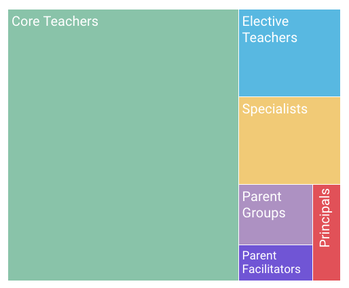|
The 2017-2018 school year has been a tremendous success! The stats below begin to tell the story of the work we've done this year:
But just as students’ work leads them to more complex questions in a PBL project, our own aims to have each student experience two high quality projects per year have led to inquiries that are more difficult to answer. They focus on the art of teaching, the methods, and systems we can use to ensure deeper learning for our students.
So to round out our year, we’ll share initial answers to this driving question: How can a school district transform the teaching and learning of over 9000 students across 9 schools, grades TK-12? We'll also share some of the new questions that will drive our learning in 2018-2019. Press on an answer below to read more about that concept, or scroll through! Answer #1
In order to for us to find success, we needed everyone to be part of this journey. That meant we needed to find a way to provide all stakeholders with a doorway into Project Based Learning. We trained all of our teachers, but quickly learned that we needed to begin customizing and expanding our training about PBL to more groups. We created customized PBL 101 and sustained support 201 workshops based on grade level and subject area, and are developing specialized 1-day trainings for PE teachers and teachers of mild-moderate and moderate-severe special education classes. We've conducted workshops for principals throughout the course of the year focused on organization, instruction and management of schools, and have worked with parent facilitators to teach them about Project Based Learning so that they can support families at their school sites. Not all will be teaching Project Based Learning in a classroom, but all need to know about its core concepts and strategies, and how they can support it through the work they do.
Answer #2
By seeing each other in action, we remove the assumptions and stories we develop, and find actual evidence of success. We deepen our knowledge of the subject we're learning, helping us see the value in continued professional learning, and just as important, helps strengthen our personal culture as well. The vulnerability we exhibit when sharing our practice helps make connections, develop authentic relationships and excitement, and creates investment. Sharing our practice has strengthened us as an organization, and has validated that we are all on this journey together. In addition to teachers and principals, the families of SLUSD love seeing the work that is happening in classrooms. We can hear the value of true engagement and participation from the family members of a student in Melissa Valdivia's classroom at Roosevelt Elementary school.
Answer #3
San Leandro Unified School District is proud of the work we've done this year, and thanks all of the teachers, principals, families, and students for their hard work! We look forward to 2018-2019, to finding new answers and new questions!
0 Comments
Leave a Reply. |
Archives
September 2019
Categories |